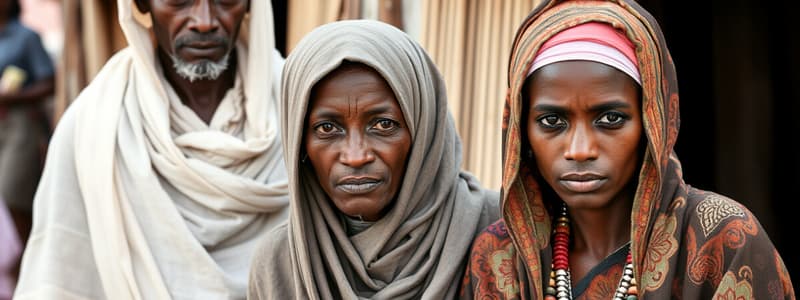Podcast
Questions and Answers
Which Sultanate succeeded the earlier Imamate of Awsa?
Which Sultanate succeeded the earlier Imamate of Awsa?
- Rahaito
- Girrifo
- Gobad
- Awsa (correct)
What played a significant role in the economy of the Awsa Sultanate?
What played a significant role in the economy of the Awsa Sultanate?
- Silk trade from Asia
- Bati-Ginda’e trade route (correct)
- Fishing along the coast
- Farming of coffee beans
What event marked the establishment of the Emirate of Harar as a significant Muslim center?
What event marked the establishment of the Emirate of Harar as a significant Muslim center?
- Imam Ahmed ibn Ibrahim's campaigns in 1527 (correct)
- The founding of the Walasma Sultanate
- Construction of the first mosque in Harar
- The migration of the Oromo people
Which version suggests that the Argoba people are not descended from Muslim-Arab immigrants?
Which version suggests that the Argoba people are not descended from Muslim-Arab immigrants?
Which Amir collaborated with the Oromo to establish a dynasty in Harar?
Which Amir collaborated with the Oromo to establish a dynasty in Harar?
What type of economy did the Somali people predominantly practice?
What type of economy did the Somali people predominantly practice?
What was the primary symbol of the Sultan in the Awsa Sultanate?
What was the primary symbol of the Sultan in the Awsa Sultanate?
What role did the Amir’s council, Majilis, serve in the Emirate of Harar?
What role did the Amir’s council, Majilis, serve in the Emirate of Harar?
Which council governed Somali society and allowed equal participation from adult males?
Which council governed Somali society and allowed equal participation from adult males?
In which geographical regions did the Afar predominantly reside?
In which geographical regions did the Afar predominantly reside?
What historical significance did Harar acquire during the mid-seventeenth century?
What historical significance did Harar acquire during the mid-seventeenth century?
What was the highest political council among the Somali that resolved conflicts and crises?
What was the highest political council among the Somali that resolved conflicts and crises?
Which historical figure mentioned the Afar people in his writings?
Which historical figure mentioned the Afar people in his writings?
What notable action did Somali contingents partake in regarding the Christian kingdom?
What notable action did Somali contingents partake in regarding the Christian kingdom?
What elements characterized the indigenous governance system of the Afar people?
What elements characterized the indigenous governance system of the Afar people?
During which century did Ibn Said note the significance of Merca town for the Somali community?
During which century did Ibn Said note the significance of Merca town for the Somali community?
Flashcards are hidden until you start studying
Study Notes
Peoples and States in the East
- Somali People: Inhabited the Horn of Africa, primarily engaged in pastoralism and nomadic movements for grazing land.
- Historical Capital: Merca, in southern Somalia, was significant in the thirteenth century as noted by Arab geographer Ibn Said.
- Military Affiliation: Somali warriors were pivotal in the Sultanate of Adal's military engagements against Christian territories.
- Governance Structure: A democratic council system known as shir governed social affairs with equal participation from adult males.
- Components of Shir: Included guurti, a council of elders, responsible for conflict resolution and overseeing essential community matters like resource management.
Afar People
- Geographic Distribution: Predominantly resided in northeastern Ethiopia, northern Djibouti, and parts of Eritrea.
- Indigenous Governance: Utilized a governance system called Makabanto, combining democratic elements with traditional practices.
- Historical Context: Mentioned by Ibn Said, the Afars occupied lowlands near Bab el-Mandeb by the thirteenth century.
- Sultanates Formation: Established several sultanates post-16th century, including Awsa, Girrifo, and Tadjourah, following the decline of Sultanate of Adal.
- Awsa Sultanate: Emerged from the Imamate of Awsa in 1577, ruled by the Mudaito Dynasty with a significant economy linked to Bati-Ginda’e trade routes.
Argoba People
- Origin Theories: Two narratives exist regarding Argoba origins; one connects them to the followers of Prophet Mohammed, while the other posits an ancient ancestry independent of Islamic immigrants.
- Religious Transition: Argoba were among the early adopters of Islam, influenced by religious leaders from Arabia.
Emirate of Harar
- Historically Significant Site: Harar was a major center of early Islam in Ethiopia; transformed into the capital of Walasma of Adal in the 16th century.
- Military Hub: Used by Imam Ahmed ibn Ibrahim for campaigns against Christian kingdoms starting in 1527.
- Administrative Development: During Emir Nur Mujahid’s rule, Harar became a fortified city with a structured governance under the Amir’s council, Majilis.
- Cultural and Economic Power: Became an Islamic cultural hub and an important trade center controlling routes from the Gulf of Aden, attracting external powers like Egyptians.
Studying That Suits You
Use AI to generate personalized quizzes and flashcards to suit your learning preferences.




